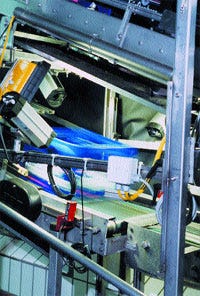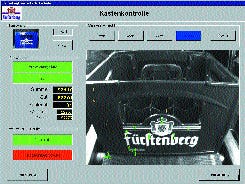January 29, 2014

Brand image is very important to Fürstlich Fürstenberg Brewery, which is now toasting its recent installation of a turnkey vision system from Cognex that quality-inspects more than 3,000 beer crates per hour (50/min). Added just more than a year ago to a bottling line in the brewery's operation in the Black Forest town of Donaueschingen, on the Danube River in Southern Germany, through a partnership between Cognex and systems integrator Siemens Industrial Solutions and Services, the system has been operating without a hiccup, says brewery production and engineering division manager Helmut Bartels.
|
Four cameras inspect four sides of a fast-moving beer crate for defects. The cameras and their illumination sources are sealed within a rugged industrial enclosure that protects them from moisture in this washdown location. |
Bartels says the Checkpoint II vision system helps ensure that only perfect beer crates reach the shops. "Essentially, it increases brand awareness for our beer by improving the look of our retail shipping/display crates," he says.
Accommodating three varieties of Fürstenberg beers, the crate-handling line now includes a four-camera Checkpoint II PC-embedded system, which can inspect the reusable crates for a variety of defects at speeds that correspond to bottling line speeds of about 1,000 bottles/min.
The crates each hold 24 polyethylene terephthalate bottles of beer. Since the heavy-duty plastic crates are reused and trucked back and forth to stores numerous times, they can be handled roughly in daily use. However, Fürstenberg insists that damaged or dirty crates should not reach customers, as they could leave a negative impression or have a negative effect on the next purchase. A price label left on a crate from a previous special offer could annoy both retailers and consumers, the brewery notes. It was possible previously for a dirty or damaged crate to slip through the cracks during what had been a more laborious manual quality-check procedure. Not any more.
"We looked for an economical way of solving problems with dirty and damaged beer crates and a labor-intensive checking process," Bartels says. "We also wanted to obtain continuously updated statistical overviews of our stock of crates."
Bartels says the brewery needed a powerful image processor that was not only compact but that also could be integrated with existing conveyors without extensive modifications. But while the bottle-cleaning/filling operation has image-processing systems, there didn't seem to be a complete system solution available for this particular application. The search for a system became an involved project, and included a series of criteria at the rejection level, with high reliability, for two different types of crates.
Appearance counts
"We wanted something off-the-shelf that could function with wet beer crates during water-spray washdowns, in humid and in changing-light conditions," Bartels explains. "We also wanted a highly adaptable system that could address our changing needs."
Designed to merge powerful yet flexible vision software with a versatile hardware platform, image-acquisition, and communications, Checkpoint II is built with an embedded, onboard vision processor that reserves the host PC for applications such as motion control or process monitoring, so there's no risk that it will interrupt or delay the host PC from functioning during a production run.
|
After being washed, empty crates travel to the inspection station and then to an automatic bottle-loading station. |
Combining ease-of-use with the power and flexibility of a programming language, the vision system is based on a high-performance vision board with four camera inputs, a Basic visual user interface with program developed by Siemens, an integrated, 400-mHz vision processor, its own working memory, and support of an Intel MMX instruction set.
Installed within a three-day period, immediately followed by a normal three-shift schedule, the system proved it could meet Fürstenberg's requirements. Says Martin Sluzewski of Siemens Industrial Solutions in Freiburg, "We couldn't seem to find a ready-made vision solution that would meet all of their needs until we discovered Checkpoint II. The system was the only one that demonstrated the potential for quick installation and implementation, and that could meet all of their inspection criteria. Because of Cognex's support and experience as a vision partner, we were able to get into the project very quickly."
As significant as the inspection equipment hardware is to assuring crate integrity, so too, is the powerful PatMax object-location software, designed to the brewery line's specific needs, Cognex tells PD. Equipped with geometric pattern-matching tools that can locate the position of objects by analyzing their basic geometric structure, PatMax can accurately seek objects despite changes in their angle and size, and can also tolerate variations in crate appearance caused by process variations, reflective surfaces, any obstructions, nonlinear changes in lighting, or uneven image formation. Cognex indicates that this can ease lighting and fixture requirements, resulting in lower manufacturing costs and greater production line flexibility.
Four eyes better than one
The four high-resolution CCIR black-and-white analog cameras each have a wide-angle lens and are mounted on a belt conveyor that leads the empty crates to an automated loading area. The cameras check each crate simultaneously as they travel at a rate of one crate/sec. Surrounding the crate-inspection station, the cameras as well as the illumination unit are protected from humidity by a rugged industrial enclosure. That's especially important, since the inspection station immediately follows an empty crate-washing station on the line, and crates are often still wet when they're inspected. For space reasons on the line, the cameras couldn't be set up to view all four faces of the crates square-on, PD is told. Some of the cameras view the crate at an angle, which could create a distorted image. But the customized PatMax software compensates for such angles, locating the position of the crate despite variations in appearance, at accuracies to within 1/4 pixel.
|
Above, project manager Georg Catterfeld points to the camera mounts on the line. Adjusting parameters is easy, with the help of a graphic user interface, below. |
|
As crates pass the cameras, the cameras scan for defects, checking the beer crates for reusability, visual appearance and mechanical defects. The system will automatically reject them, if necessary, using a pneumatic pusher arm, into a bin, after which they're sorted and passed to an additional cleaning area for restoring, or they are destroyed if their condition is unacceptable, Bartels says. Detection criteria include a minimum of dirtiness (1 cm2 of dirt, glue or label residue), and damage to imprints or the coat-of-arms logo and crate size data; and mechanical defects, including breaks or chips.
The PatMax software analyzes complex patterns in the brewery logos imprinted on the faces of the crates, as well as the content label and the brewery's coat-of-arms imprinted on the crate. A "blob" tool looks for foreign bodies on the crate with a minimum size setting in pixels. A grey-value threshold parameter defines the point from which a foreign body affects the analysis. The "minimum edge gap" parameter defines how many pixels must separate a pair of edges for it to be defined as a fault. A light meter tool detects foreign bodies and defects by examining the average brightness of an area, and compares such items as the flags printed in the coat-of-arms logo to a stored reference image.
Inspects at 800 milliseconds/crate
The system checks each crate for all of these factors within approximately 800 milliseconds. After they're inspected, acceptable crates are automatically loaded with bottles on a Krones system.
Says Fürstenberg's Georg Catterfeld, who was responsible for the inspection project, "We were very impressed by the quick installation, productive capacity and reliability of this system."
Brewery personnel can easily adjust the vision system at any time, thanks to the system's Microsoft Visual Basic user interface. Geared to the brewery's particular needs, the interface displays specific information about each crate inspected. Personnel can make all adjustments on the preprogrammed system simply by changing parameters.
Being the first machine vision system in the beer-crate-handling department, Checkpoint II has passed the inspection hurdle with the brewery's prost. Fürstenberg says it is expanding production capacity and plans to add yet another inspection system to its lines.
More information is available:
Inspection system: Cognex, 508/650-3344. Circle No. 218.
System integrator: Siemens AG, Industrial Solutions and Services, 49 761 2712 287. Circle No. 219.
Bottle loaders: Krones, Inc., 414/409-4100. Circle No. 220.
About the Author(s)
You May Also Like






